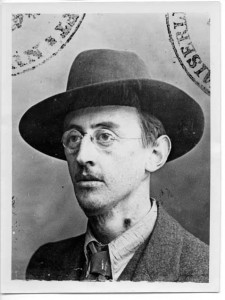The ‘Castle Document’
Published in Editorial, Issue 2 (March/April 2016), Volume 24By Joseph E.A. Connell Jr

There was a small press at Count Plunkett’s home of Larkfield, Kimmage, on which it is said that the ‘Castle Document’ was printed on 13 April 1916. This document alleged that the Dublin Castle authorities proposed to arrest many important public figures, and to raid homes and buildings:
‘First, the following persons are to be placed under arrest—All members of the Sinn Féin National Council; the Central Executive Irish Sinn Féin Volunteers; General Council Irish Sinn Féin Volunteers; … Coisde Gnotha Committee Gaelic League.
The following premises will be occupied … First, premises known as Liberty Hall …; number six Harcourt Street, Sinn Féin Building; number two Dawson Street, Headquarters Volunteers; … number twenty-five Rutland Square, Gaelic League Office; … Sinn Féin Volunteer premises in city; all National Volunteer premises in city; … Surrey House, Leinster Road, Rathmines.
The following premises will be isolated and all communication to or from prevented—Premises known as Archbishop’s House, Drumcondra; Mansion House, Dawson St.; number forty Herbert Park; Larkfield; Woodtown Park; Saint Enda’s College, Hermitage, Rathfarnham …’
The consensus is that after Joseph Plunkett ‘forged’ the document he sent Rory O’Connor with it from Miss Quinn’s private nursing home to Kimmage. O’Connor took it to George Plunkett and Colm Ó Lochlainn to print it. Its provenance has never been proven, however. Thomas MacDonagh’s son, Donagh, claimed that there really was a directive that all the leaders of the separatist organisations should be arrested ‘immediately on receipt of an Order from the Chief Secretary’s Office … and signed by the under-secretary and the General Officer Commanding the Forces in Ireland’.
This document was branded as bogus by the British authorities, but Grace Gifford Plunkett stated that she was present while Plunkett decoded part of it:
‘I remember the document that was published because I wrote it out myself for Joe, sitting on his bed in Larkfield House. Joe did not do it in the nursing home … It did come out from the Castle, I know who brought it out. Donagh MacDonagh was married to a girl named Smith. It was her father that brought it out.’
Eugene Smith was a telegrapher in Dublin Castle, and he gave Patrick J. Little a signed and witnessed statement that he recognised the document as genuine and abstracted from the Castle files. And in Kilmainham Gaol, on the night before he was executed, Seán MacDermott swore to Msgr Patrick Browne that the document was genuine. Moreover, it had several ‘errors’ that Joseph Plunkett was unlikely to have made.
Little was the editor of New Ireland, which first published the document. According to Little’s article, Rory O’Connor produced the document at a meeting in Dr Séamus O’Kelly’s house in Rathgar. Then Alderman Thomas Kelly read it at a Dublin Corporation meeting on 19 April, indicating that he had received it from Little. Kelly was highly regarded by all parties and thus the document was taken very seriously.
On 19 April 1916, Eoin MacNeill, as commandant of the Volunteers, drafted an order in response to the ‘Castle Document’ which included the following instructions: ‘Your object will be to preserve the arms and organization of the Irish Volunteers, and the measures taken by you will be directed to that purpose’.
MacNeill, Arthur Griffith, the O’Rahilly, Seán Fitzgibbon, Liam Ó Briain, Joseph Plunkett and Seán MacDermott met at Dr O’Kelly’s home at various times on Holy Saturday (22 April) night. By then, MacNeill was convinced that the ‘Castle Document’ was a fake. Thereafter he dispatched messengers throughout the country with countermanding orders for the Sunday rising: ‘Volunteers completely deceived. All orders for special action are hereby cancelled, and on no account will action be taken.’
Joseph E.A. Connell Jr is the author of Who’s who in the Dublin Rising (Wordwell Books).
Further reading
J. Brennan, ‘The Castle Document’, Irish Times, 28 March 1958.
G. Gifford, Witness Statement no. 257.
F.X. Martin (ed.), Leaders and men of the Easter Rising (London, 1967).
















